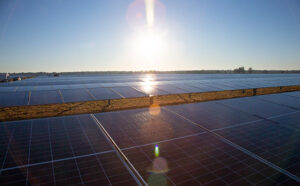
Cool Springs Solar Energy Center, an example of a NextEra solar site. Credit: NextEra Energy Resources
Wake Forest University and eight other colleges and universities in North Carolina and Pennsylvania are joining forces to bring a large-scale solar facility online in western Kentucky. By collaborating on this Power Purchase Agreement (PPA), the schools are accessing the benefits of renewable energy through an arrangement typically only feasible for large customers.
Wake Forest will be purchasing an amount of energy equal to 100% of the current electricity used on campus for 20 years. While electricity generated by the Sebree Solar II project cannot be transmitted directly to campus because of distance, Wake Forest University will receive renewable energy credits (RECs) to account for greenhouse gas emissions related to our purchased electricity.
“This is Pro Humanitate in action. In joining this consortium, the first higher education renewable energy aggregation in North Carolina, we are catalyzing an innovative partnership to tackle the environmental impacts of our operations and signifying our commitment to environmental wellbeing for present and future generations of Wake Foresters,” said Wake Forest President Susan R. Wente.
The solar facility will be located near the town of Robards, Kentucky, not far from the Ohio River. The Sebree Solar II project will offer considerable environmental benefits as the project will generate up to 150 megawatts of clean, renewable energy. Over its 30-year lifespan, the solar site will contribute approximately $12 million in additional tax revenue to Henderson County, which can be used for roads, schools and other public services.
Climate neutral by 2040
In 2020, the University committed to reaching climate neutrality in operations by 2040. From a 2007 baseline, Wake Forest has already achieved a 46% reduction in total greenhouse gas emissions from operations. Through consistent investment in building renewal and energy efficiency, as well as a reduction in the carbon intensity of the electrical grid, emissions have continued on this impressive downward trend, even as the campus has grown 56% over that same timeframe.
“This agreement is one of the single largest steps we can take toward reaching our climate neutrality goal,” said Executive Vice President and Chief Financial Officer Jacqueline A. Travisano. “It builds on the work led by our utilities operations team in Facilities and Campus Services, who work to optimize plant performance and efficiency across campus.”
Engaged and experiential learning
The Sebree Solar II project is set to begin construction in early 2025 and commence commercial operation by the end of 2026. The solar site is projected to provide enough energy annually to power over 24,000 homes when complete. The institutions in the cohort will receive access to data from the Sebree Solar II project for classroom use, as well as campus speaking engagements, site visits, and student internships.
“From engineering to politics and international affairs to the ongoing work in all of our graduate and professional schools, the educational co-benefits of this project are considerable,” said Provost Michele Gillespie. “This project will allow our students and faculty to study the complexities of a renewable energy transition in real-time through coursework, experiential learning opportunities, and internships.”
The nine institutions – Wake Forest, Davidson College, Elon University, Lehigh University, Dickinson College, Haverford College, Lafayette College, Muhlenberg College, and Swarthmore College – selected the Sebree Solar II project based on shared criteria, including minimized risk, regional proximity, and the cost structure of the agreement. Guided by Coho, an ERM Group Company, the institutions are working with NextEra Energy Resources, the world’s largest generator of renewable energy from the wind and sun, and a world leader in battery energy storage.
Learn more on the the Office of Sustainability website.
Categories: Inside WFU
Recent Posts
-
May 3, 2024
-
May 2, 2024
-
May 2, 2024
